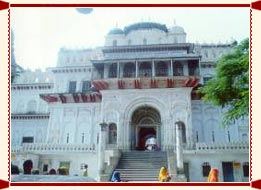Ayodhya
Ayodhya also known as Saket, is one of the most holiest and ancient city of India in Faizabad district of Uttar Pradesh. It is considered to be the birth place of Hindu deities Rama and Swaminarayan. Ayodhya is located on the right bank of river Saryu. For centuries, it was the capital of the descendants of the Surya dynasty of which Lord Rama was the celebrated King.Ayodhya during ancient time was known as Kaushaldesa.It is a city of immense antiquity full of historical significance and sacred temples.The Atharvaveds described Ayodhya as 'a city build by Gods and being prosperous as Paradise itself.' The city is considered to be named after its founder, King Ayudh (unconquerable), one of the forefathers of Lord Rama.
How to reach here:
By Air: Nearest Airport is Lucknow Airport (130 Kms) or Allahabad Airport (160 Kms).
By Rail: Nearest railway station is Faizabad station which is 6 Km from Ayodhya. It is connected to major cities in India.
Best time to visit: October to March
Must eat: Exotic Indian food
Famous Restaurants: Pathik Niwas Saket Hotel, Shri Ram Hotel
Places you must visit:
Ramkot Citadel is situated on an elevated ground in the western part of Ayodhya.Altough visited by millions of pilgrims throughout the year, this sacred place attracts devotees from all over India and abroad on 'Ram navami', the day of Lord Rama's birth. The whole area is surrounded by other temples and maths. It is believed that Hanuman used to guard this citadel from a secret cave.

Ramjanmabhoomi is the most venerated site of an ardent Hindu and the temple is now open for the public after a long gap.Common belief is that there was a temple of Lord Rama and it was demolished as per the orders of Mughal Emperor Babur and a mosque was built on its ruins.It is a controversial tract of land between Hindus and Muslims.

The Hanuman Garhi is situated in the center of the town. It has 76 stairs. Legends say that Hanuman lived here in the cave and guarded the Ramkot.The temple has a statue of Anjani mata with Bal Hanuman on her lap.The belief is that all your wishes are granted with a visit to this holy shrine.It is a massive structure in the shape of four sided fort with circular bastions at each corner houses a temple of Hanuman.

Kanak Bhawan temple also known as Sone-Ka -Ghar has statues of Sri Ram and Sita bejeweled with gold ornaments. It is believed that Kaikeyi (mother of Bharat) built this temple as a mark of repentance.But history says that Queen of Tikamgarh, Virshbhanu Kuvari built this temple in 1891.

Swarg Dwar ....according to mythology, Lord Rama is said to have transformed himself into Lord Mahavishnu and left for Vaikunth.

Nageshwarnath Temple is said to have been established by Kush, the son of Lord Rama.According to the legends, Kush lost his amulet , while bathing in the Saryu, which was picked up by Nag-kanya , who fell in love with him. As she was a great devotee of Lord Shiva, Kush built this temple for her. It is said that this is the only temple to have survived till the time of Vikramaditya, the rest of the city had fallen into ruins and was covered by dense forests.It was by the means of this temple Vikramaditya was able to locate Ayodhya and the sites of different shrines here. The festival of Shivratri is celebrated with great pomp and splendor.

Mani Parbat and Sugriv Parbat - The first of these ancient earth mounds is identified with a stupa build by Emperor Ashoka, while the second is believed to be an ancient monastery.

Treta Ke Thakur is a temple built where Lord Rama is said to have performed the Ashvamedha Yajnya. About 300 years ago the Raja of Kulu, built a new temple here, which was improved by Ahilya Bai Holkar of Indore in 1784, at the same time the adjoining ghats were also made.The initial idols in black sandstone were recovered from the Saryu river and placed in the new temple, famous as Kaleram-ka-mandir.

Lakshman Ghat is on the banks of Sarayu river. This is where Ram's brother Lakshman is said to have voluntarily given up his life-an act called samadhi. Another version says that he gave up living after he broke a vow.

Birla Temple is an outstanding marble temple that enshrines the images of Lord Rama, Sita and Lakshman.

Guptar Ghat is a famous pilgrim spot that encloses a sequence of well maintained ghats built by Raja Darshan Singh in early 19th century. 'Gupt' means disappearance and it is believed that Lord Ram has left his body at this spot while on his eternal journey.Major points of attractions include Chakra Harji Vishnu temple, Gupta Harji temple and Raj Mandir.There is also an imprint of Lord Ram's feet here.

Vijay Raghav Temple is the best temple in Ayodhya built in 2008. In this temple Lord Ram is presented in 12 forms called Vishva virat. This temple was made by red marbles and stainless steel.

Dashrath Mahal is the palace of King Dashrath also caled as Bada Asthana or Badi jagah, located in the Ramkot area of Ayodhya.

Digambar Jain Temple (Badi Murti) is a place where five Tirthankars were born and preached their religious values.Kesari Singh, the Nawab of Faizabad, got the five Jain shrines constructed to mark the birth place of these Tirthankars, in 1781 Vikrami. this temple is believed to be very old(Treta yug) and was later renovated by Vikramaditya.A magnificient 31 feet high marble statue of Rishabhdev( the first Tirthankar) is installed here.
No comments:
Post a Comment